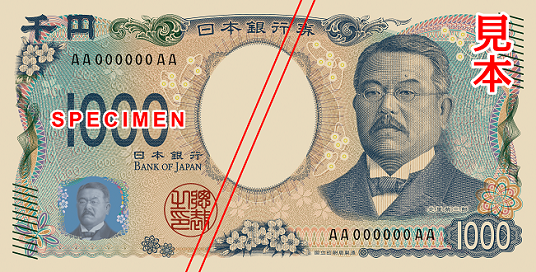
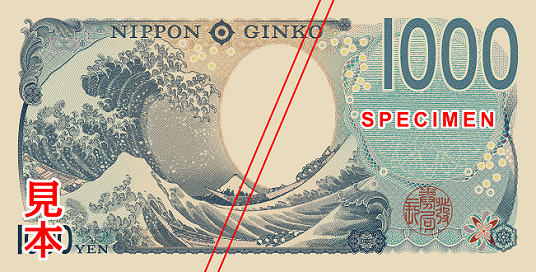
| Design | The front features Shibasaburō Kitasato who invented tetanus serum therapy, discovered the plague bacillus, and founded the Institute for Infectious Diseases and Kitasato Institute, contributing to training future generations. The back depicts “Under the Great Wave off Kanagawa,” one of the most famous works by the ukiyo-e artist KATSUSHIKA Hokusai in Edo era, which is highly recognized and has influenced artists around the world. |
|---|---|
| Size | 76 mm (height) × 150 mm (width), the same size as the current 1,000 yen note. |













High-definition watermark
In addition to the current type of watermark, a high-definition watermark has been newly added. The portrait is surrounded by a continuous pattern composed of intricate lines.

Intaglio printing
The main designs on banknotes, including the portrait, are printed using the intaglio printing method. Specifically, for the denomination numerals and the text “日本銀行券” (Bank of Japan note), a technique known as intaglio printing is employed, where ink is applied thickly to create a greater relief.

3D hologram
A hologram is newly added to 1,000 yen note. New cutting-edge technology is used, and it can be used to rotate the portrait in 3D.This technology has been adopted for the first time in banknotes in the world.


Luminescent ink
When ultraviolet light is shone, the seal on the front (the seal of the Governor of the Bank of Japan), and patterns on both sides become luminescent.


Microprinting
“NIPPONGINKO” is printed in microscript that cannot be reproduced with color photocopiers.

Latent image
By tilting, the characters “NIPPON” appears on the back side.

Pearl ink
When tilting, a pink-colored sheen emerges at the center of both the left and right ends of the banknote.


tactile marks
Tactile marks by intaglio printing with a textured feeling are employed to help the visually handicapped distinguish different notes with their fingers. The mark is placed at the upper right and lower left on the front on the 1,000 yen note.

Watermark-bar-pattern
Watermarks in bar patterns are embedded in the paper. When seen against the light, 1,000 yen note has 1 bar.
-
- High-definition watermark
 In addition to the current type of watermark, a high-definition watermark has been newly added. The portrait is surrounded by a continuous pattern composed of intricate lines.
In addition to the current type of watermark, a high-definition watermark has been newly added. The portrait is surrounded by a continuous pattern composed of intricate lines.
-
- 3D hologram
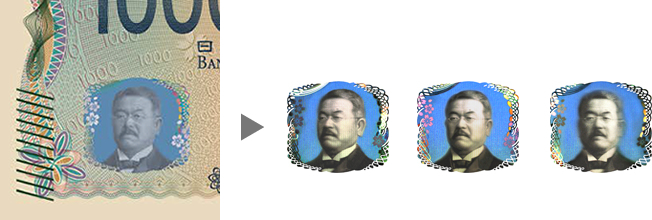 A hologram is newly added to 1,000 yen note. New cutting-edge technology is used, and it can be used to rotate the portrait in 3D.
A hologram is newly added to 1,000 yen note. New cutting-edge technology is used, and it can be used to rotate the portrait in 3D.
This technology has been adopted for the first time in banknotes in the world.
-
- Latent images

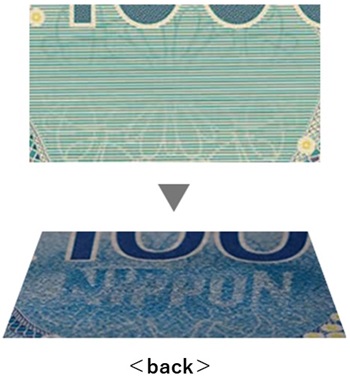 By tilting, the characters “NIPPON” appears on the back side.
By tilting, the characters “NIPPON” appears on the back side.
-
- Pearl ink
 Not visible from the front, but when tilting a note, a pink pattern emerges at the center of either end of the note.
Not visible from the front, but when tilting a note, a pink pattern emerges at the center of either end of the note.
-
- Microprinting

 “NIPPONGINKO” is printed in microscript that cannot be easily reproduced on color copy machines.
“NIPPONGINKO” is printed in microscript that cannot be easily reproduced on color copy machines.
-
- Intaglio printing
 The main designs on banknotes, including the portrait, are printed using the intaglio printing method. Specifically, for the denomination numerals and the text “日本銀行券” (Bank of Japan note), a technique known as intaglio printing is employed, where ink is applied thickly to create a greater relief.
The main designs on banknotes, including the portrait, are printed using the intaglio printing method. Specifically, for the denomination numerals and the text “日本銀行券” (Bank of Japan note), a technique known as intaglio printing is employed, where ink is applied thickly to create a greater relief.
-
- Tactile marks

 Tactile marks by intaglio printing with a textured feeling are employed to help the visually impaired individuals distinguish different notes with their fingers. The mark is placed at the upper right and lower left on the front on the 1,000 yen note.
Tactile marks by intaglio printing with a textured feeling are employed to help the visually impaired individuals distinguish different notes with their fingers. The mark is placed at the upper right and lower left on the front on the 1,000 yen note.
-
- Watermark-bar-pattern
 Watermarks in bar patterns are embedded in the paper. When seen against the light, 1,000 yen note has one bar.
Watermarks in bar patterns are embedded in the paper. When seen against the light, 1,000 yen note has one bar.
-
- Luminescent ink

 When ultraviolet light is shone on a note, the seal of the Governor of the Bank of Japan on the front side, and part of the background pattern on either side, become luminous.
When ultraviolet light is shone on a note, the seal of the Governor of the Bank of Japan on the front side, and part of the background pattern on either side, become luminous.
Design
-
- Changes in shapes and arrangements of tactile marks

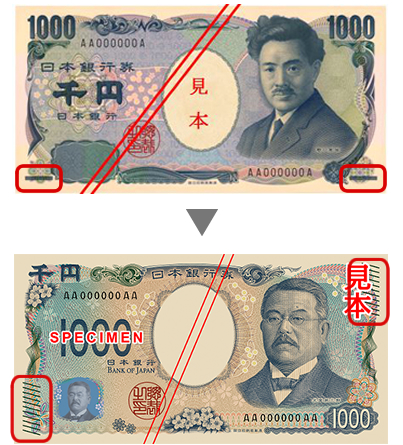 The shape of the tactile mark is conformed to 11 diagonal lines for excellent finger sensitivity. The mark is placed at the upper right and lower left on the front on the 1,000 yen note.
The shape of the tactile mark is conformed to 11 diagonal lines for excellent finger sensitivity. The mark is placed at the upper right and lower left on the front on the 1,000 yen note.
-
- Enlarged numerals of face value
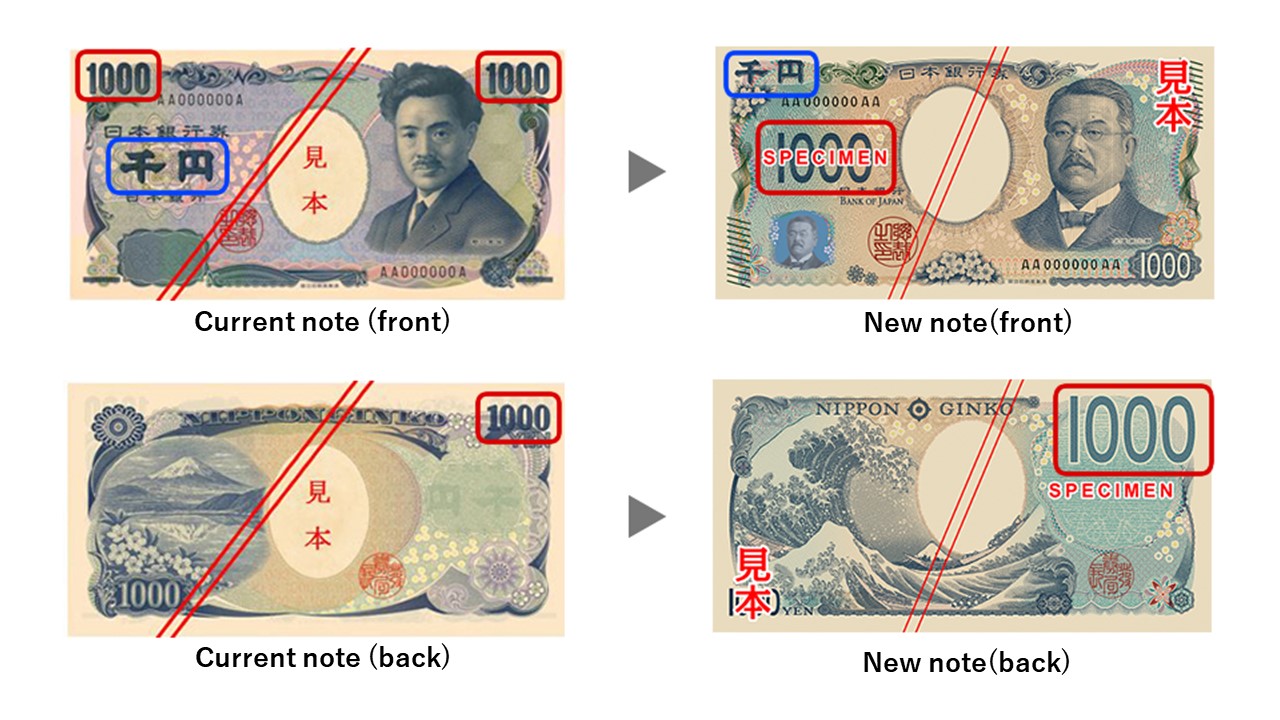
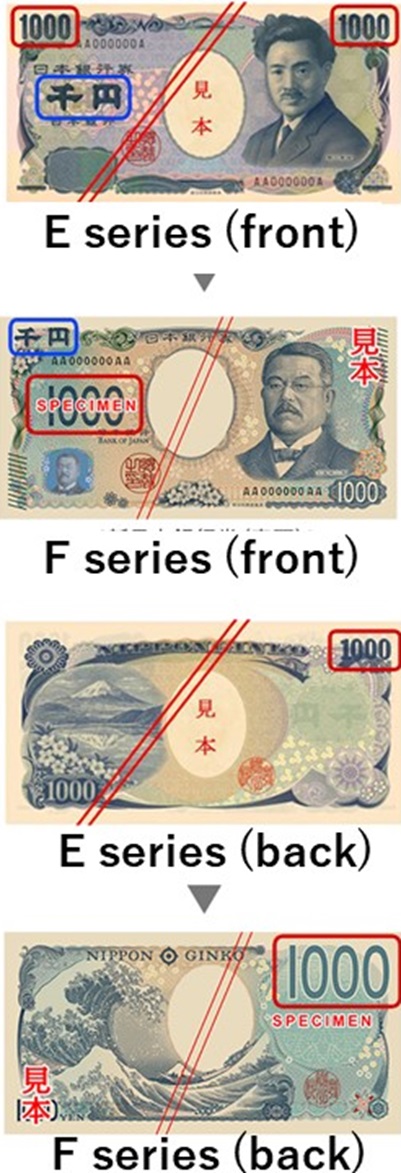 Arabic numerals, familiar to many people regardless of age or nationality, are used for face value numbers and have a larger font than that of current notes.
Arabic numerals, familiar to many people regardless of age or nationality, are used for face value numbers and have a larger font than that of current notes.

